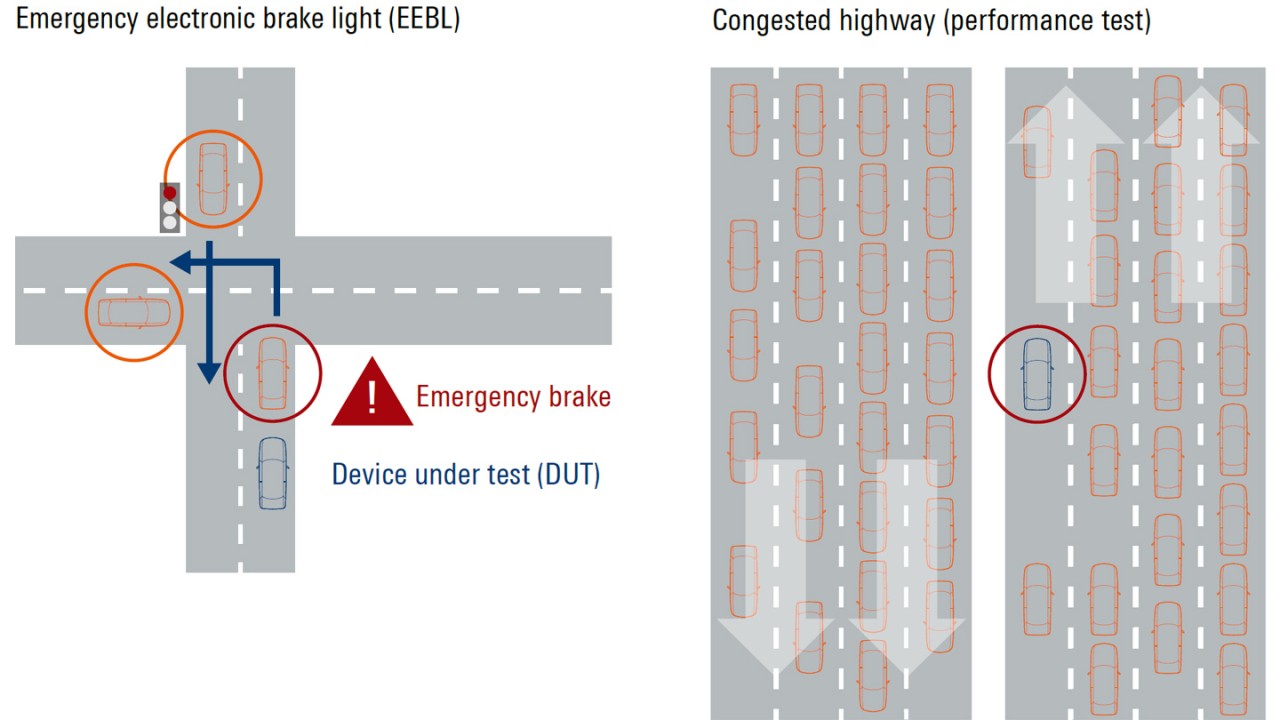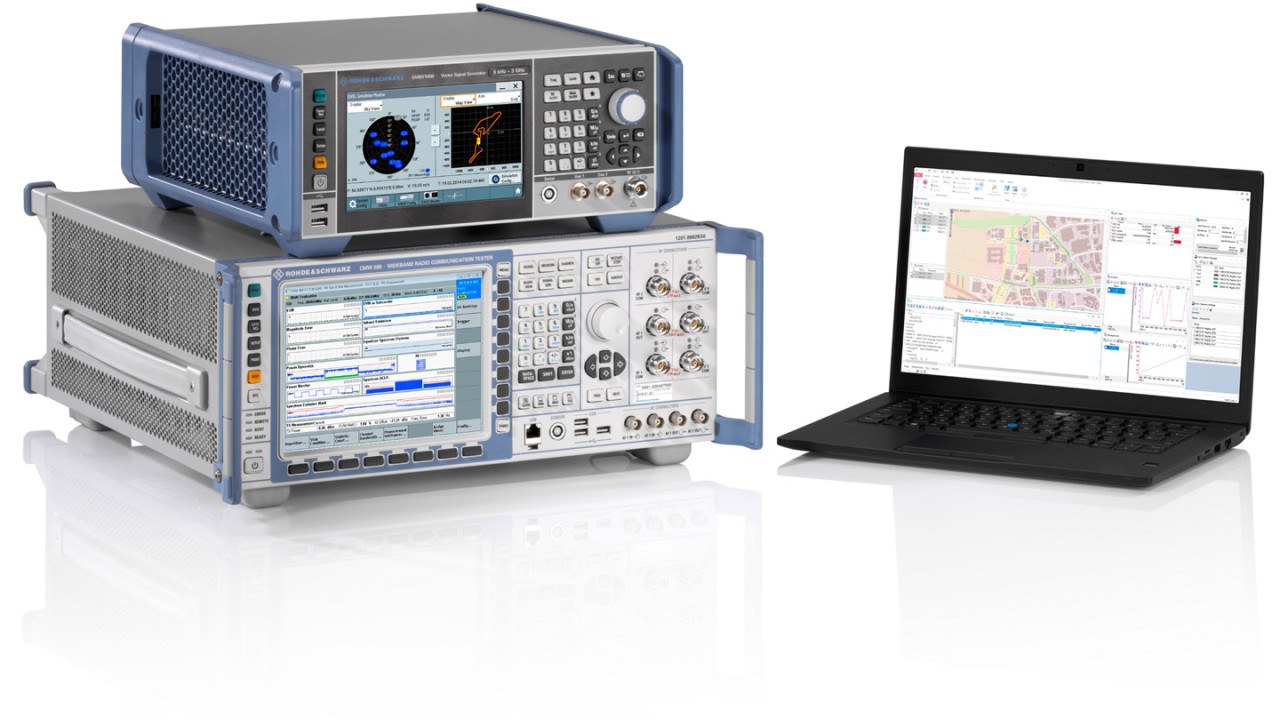Scenario based testing of safety-critical cellular V2X applications in a lab environment
Create and simulate detailed traffic situations for the verification of cellular V2X (C-V2X) connectivity.

Create and simulate detailed traffic situations for the verification of cellular V2X (C-V2X) connectivity.
For several years, automobile manufacturers and government agencies have sought ways to increase road safety, manage traffic efficiently and, in the future, make it more comfortable. Vehicle-to-everything (V2X) is a new generation of information and communications technologies that connect vehicles to everything. V2X is designed to offer low-latency vehicle-to-vehicle (V2V), vehicle-toroadside infrastructure (V2I) and vehicle-to-pedestrian (V2P) communications to add a new dimension to future driver assistance systems. Cellular V2X (C-V2X) as one communications standard defined by 3GPP in Release 14 uses LTE technology as the physical interface for communications. The standard describes two modes. The vehicle- to-network (V2N) mode, with communication over the Uu interface, uses traditional cellular links to enable cloud services to be integrated into end-to-end solutions, e.g. to allow road and traffic information for a given area to be distributed to the vehicles.
The second mode is referred to as direct or sidelink mode (V2V, V2I, V2P), where communication takes place over the PC5 interface. In that mode, C-V2X does not necessarily require a network infrastructure. It can operate without a SIM and without network assistance and uses GNSS as its primary source for time synchronization.
The first commercial deployment of C-V2X direct communications based on LTE 3GPP Release 14 is scheduled to take place in China by 2020/21. This initial trial will require comprehensive testing. Verifying system functionality and performance exclusively by field testing in a real-world environment can be time-consuming, costly and very challenging. Requirements regarding functionality, and consequently the required assistance functions, are constantly changing. Test solutions are needed during the development and introduction phase to verify compliance with the standards. The PC5 direct communications mode allows a highly reliable exchange of time sensitive and safety relevant information. Using a mobile communication tester together with a C-V2X scenario simulation tool delivers reproducible test scenarios. This is essential for the standardization of verification processes for C-V2X in order to obtain reliable and comparable results, and it helps to demonstrate that end-to-end functionality between two C-V2X devices from different vendors works properly.


Rohde & Schwarz, in cooperation with the automotive test tool provider Vector, has developed a new test architecture for testing and verifying safety-critical C-V2X applications in a lab environment. The Rohde & Schwarz test setup comprises an R&S®CMW500 wideband radio communication tester and an R&S®SMBV100B GNSS simulator, combined with the comprehensive Vector CANoe .Car2x simulation tool. The R&S®CMW500 uses a C-V2X software package to simulate the physical and MAC layer in order to transmit and receive data over the PC5 radio interface.
The R&S®SMBV100B, acting as a GNSS signal generator, delivers precise synchronization information for out-of-coverage communications in C-V2X mode as well as very accurate position information to the device under test (DUT).
This information is required, for example, for V2X basic safety messages (BSM). The R&S®CMW-KAA550 C-V2X application adapter for the Vector tool links the instruments to the CANoe .Car2x software environment for V2X application testing. The Vector tool offers comprehensive functionality to configure and run traffic scenarios so that the functions of the electronic control unit (ECU) can be thoroughly tested. Users can create and simulate detailed traffic situations to verify C-V2X connectivity including security and certificate management for the intended application.
An easy to handle graphical scenario editor helps users create traffic scenarios. When a scenario is started in CANoe .Car2x, the software tool generates the corresponding ITS communications messages based on the configured test scenario using the relevant ITS stack variant for the target market (North America, Europe, China) in line with specifications. The messages and route information for that scenario are forwarded to the R&S®CMW500 and the R&S®SMBV100B via the R&S®CMW-KAA550 C-V2X application adapter for Vector, providing the radio access layer to the DUT. This allows stimulating a C‑V2X control unit in line with the particular situation and to test the implemented functions such as:


Test scenario examples - the device under test is verified in a scenario with multiple simulated cars and receives an emergency electronic brake light message or is tested in a congestion scenario.
The test solution presented here allows testing safetycritical C-V2X applications in a lab environment, providing reliable and repeatable results. The Vector CANoe .Car2x software tool in combination with Rohde & Schwarz instruments provides the ability to create complex and reproducible C-V2X scenarios to stimulate a C‑V2X control unit in line with the configured situation and to test the implemented functions in a targeted manner. The test solution is a future-ready investment, with the option to be extended with an R&S®CMX500 radio communication tester to accommodate future C-V2X releases, including 5G New Radio (5G NR), to keep up with the latest developments of C-V2X.


Cellular V2X end-to-end application layer test solution based on the R&S®CMW500 wideband radio communication tester and the R&S®SMBV100B GNSS simulator in combination with the Vector CANoe .Car2x software tool for simulating, developing and testing V2X based communications applications.